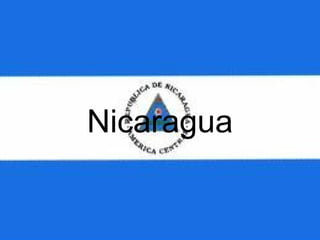
Nicaragua pp blog
- 1. Nicaragua
- 2. Nicaragua a Brief History In 1524 Hernandez de Cordoba established the first permanent settlement in Nicaragua. In 1821 Nicaragua gained its independence from Spain and became for a short period part of the Mexican Empire. In 1938 Nicaragua became Nicaragua. In 1856 an American named William Walker led a private army into Nicaragua and became president. He was overthrown by a Central American coalition and was executed in 1860. In 1909 the U.S. occupied Nicaragua due to U.S. investments which were granted to them by Nicaraguan bourgeoisie, but deemed illegitimate by the acting Nicaraguan president Jose Santos Zelaya. The U.S. left in 1933 when they were satisfied they could economically rape Nicaragua’s resources.
- 4. The Somoza Family Dictatorship From 1930-1979 Nicaragua was controlled by the Somoza family. From 1936 to 1956 Garcia Somoza ruled Nicaragua. Such a long reign was possible due to owning much of the Nicaraguan economy as well as having (or controlling) the support of the countries military. He was also supported by powerful bourgeoisie in the U.S. which helped concretize his political will in Nicaragua. When Garcia Somoza came to power he handed over important government positions to family members as well as placing his family and friends in judicial positions. This guaranteed that the law would bend to his will.
- 5. Garcia Somoza and Roosevelt Garcia and his sons
- 6. Various coups happened throughout this period in which Somoza was able to hold onto power, until 1956 when he was shot by a young 27 yr old poet named Rigoberto Lopez Perez. 8 days later he died in the Panama Canal Zone where he was sent for medical attention. Garcia’s son succeeded him and due to his fathers assassination there was a suspension of civil liberties and wide spread torture of political opposition was documented. Throughout the Somoza family regimes they espoused anti-communist rhetoric which helped garner support of the U.S. The Somoza family even allowed the Bay of Pigs invasion of Cuba to be launched from Nicaragua. In 1972 an earthquake killed nearly 10,000 people and left 80% of Managua’s (the capital) commercial centers in ruin. During this time the Somoza family amassed major wealth by wide spread corruption and theft of international aid organizations.
- 9. In 1979 Anastasio Somoza fled Nicaragua due to the increasing revolutionary front by the Sandinistas. This ended the Somoza family dominance of Nicaragua. He fled to Miami and then Paraguay where he was assassinated by the Sandinistas in 1980. One of the Sandinista assassins was quoted saying "We cannot tolerate the existence of millionaire playboys while thousands of Latin Americans are dying of hunger. We are perfectly willing to give up our lives for this cause."
- 10. The Sandinista National Liberation Front
- 11. The FSLN was a Marxist group formed in the early 1960’s in response to the Somoza dictatorship. By 1979 they had grown in power militarily, and popularly. They were able to overthrow the government in 1979 and they remained in power until 1990. Throughout this time they implemented mass literacy campaigns and focused on better health care for the poor. While these initiatives were great they had to deal with the Contra’s a U.S. backed and trained rebel group. Needless to say this put a damper on the progress of the people’s revolution. The rebels were made up of Somoza military loyalists and the dictator Ronald Reagan was quick to support these murderers. In 1983 the U.S. government stopped funding the Contra’s officially. So the CIA took it on and in one of the worst crimes against humanity, started funding the Contra’s with the support of Ronald Reagan and the CIA by importing cocaine into the U.S. Thus began the crack era in the U.S.
- 13. The FSLN held Nicaragua’s first truly democratic election in 1984 and won by a landslide. In the 1990 election FSLN lost and their reign was ended. Throughout their rule they were denounced by Washington as being a dictatorship but yet free elections were held and power conceded when the people voted against them in 1990. More proof that the U.S. ruling class can only have democracy in its own country by making sure they have dictators around the world who are on their knees for them. The FSLN was cited as violating human rights due to its mass killings of Somoza military thugs after the revolution. This cannot be ignored and can partially be explained by the hate in the hearts of the people who suffered miserably under the Somoza/U.S. dictatorship. In 2006 Daniel Ortega former FSLN president of Nicaragua once again won the election. With this victory he joined ALBA. ALBA is an economic bloc established by Latin American countries to break away from the dehumanizing free trade hegemony of the U.S. While FSLN has lost much of its revolutionary fervor of the 20th century it seems to hold the publics support.
- 15. Nicaragua Facts Population: 5,785,846 Capital: Managua Population below the poverty line: 48% (2005) Ethnicity: Mestizo 69%, White 17%, Black 9%, Indigenous 5% Language: 97% Espanol Literacy: 65% Average schooling is 11 years